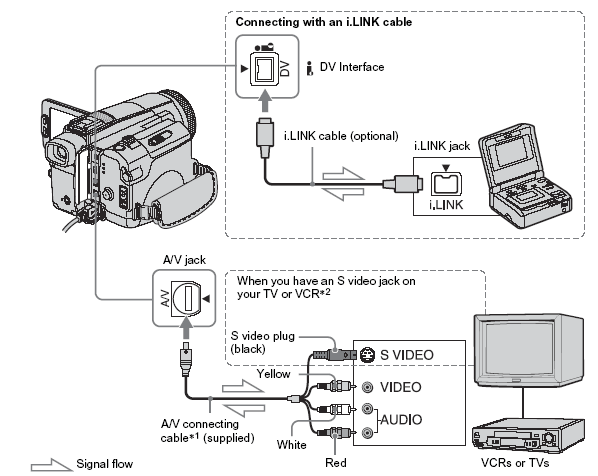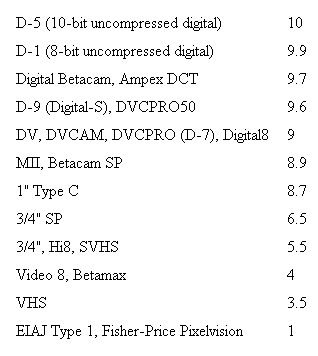A videotape can be played back on consumer grade equipment and recorded by newer video equipment that uses an equal, or lesser, quality format. This could be called preservation, but it is the process of making a Use Copy.
A Use Copy is the copy that is played-back by users. The original copy (Master) should not be used on a day-to-day basis. Each play will degrade the original a small amount. When the tape is migrated following preservation standards, a used tape will make a poorer Master. The Use Copy is the sacrificial artifact that is degraded by patrons, archivists or other users. In some situations (high-use artifacts), a Use Submaster is created so that the numerous future Use Copy videotapes can be made without harming the Master.
If the Use Copy is used for exhibition or study, rather than the original, the original will not be damaged by further playback.
Making a Use Copy is a form of preservation, but it is far from the final solution. The final solution would be to capture the original with greater bandwidth than the original using digital capture technology.
The use of the following table, from Adam Wilt's DV website, shows that some formats are far superior to the more common VHS, S-VHS and BetaMax (analog consumer) formats. Migrating from one of them, to one of the newer linear videotape formats (DV) will not introduce too much image quality deterioration.
Most of the DV formats (see below) use lossy compression (5:1 to 3.3:1) to decrease the amount of video information stored, but the resolution will always be at 525/480 lines rather than the 200 to 300 (maybe 355 lines on a very good day) found in most on the analog consumer formats, producing an image that may appear good, but has been damaged by the migration process. In most cases, you won't be able to see the 5:1 color compression, due to the (lack of) quality of the consumer playback deck and (low resolution, 150-400 lines) TV set (rather than 600-1000 line monitor) being used for viewing, but it the image degradation is there; the Use Copy contains a significantly degraded image.
|
|
| The table above (from Adam Wilt's website) shows a comparison of DV (Digital Video) formats DV FAQ Technical with other common digital formats, excluding the digital format of ITU-BT 601 and -BT 709, although D-1 and D-5 are close, see the Video Format Chart in the Digital Migration section. |
Many Original Video Documents on Low Quality Video Formats - Low Cost Options There are many original VHS and Betamax videotapes made (1) as oral histories or (2) to document a cultural performance such as dance, drama or a happening. Since both of the consumer analog formats are about 30 years old, early videotapes (1976-78 to 1990) are approach the end of their useful lifetime. Many of these videotapes are one of a kind, and thus, should be considered Master archival documents. Some preservation measures must be taken. Two basic steps follow: (1) Make Use Copy and (2) Cool Storage.
Step 1: Make a Use Copy from the Master
It can be seen in the quality ranking above that DV formats (MiniDV, uses 5:1 lossy compression; DVCPRO 50 uses 3.3:1 compression) are superior to VHS, Betamax and S-VHS.
Making a Use Copy in another format, of the Master, halts the use of the original document. This is a good first step down the path of preservation. While the Use Copy will not be as good as it could be, it will be good enough for everyday use in an organization with a limited budget.
In the image below, from a Sony miniDV camera manual, shows how to hook-up to a VHS/S-VHS/Betamax playback deck using the A-V break-out cable, which supports either Composite ( yellow RCA connector) or S-VHS connections (4-pin DIN plug); the S-VHS (Y & C) is the preferred option. |
 |
Step 2: Cool Storage of Master (original videotape)
Cold storage of the original videotape, at recommended conditions, will prolong its life 4-6 times. At the end of this period (20-100 years) playback equipment probably won't be readily available. Therefore, practically speaking, storage at colder or dryer conditions won't provide greater permanence, even though the physical videotape would be playable if equipment were available.
Cool Storage of the original videotape in done in a sealed bag (two thick ZipLoc bags), within a dedicated refrigerator set at 45°F. Cool or cold storage will slow the deterioration of the binder layer in the videotape.
The sealed bag helps the artifact maintain its moisture content, when the temperature is lowered and then raised when pulled from cold storage. The sealed bag must also contains a few layers good quality cellulose to act as a moisture sink, such as museum quality matboard, or acid-free paper. Details on Cold Storage can be found in a PDF Cold Storage of Cultural Artifacts (2009). See also Storage of Videotape (herein) and AMIA's Storage of Videotape recommendations by Jim Wheeler and Hannah Frost.
Use of both steps will move the videotapes well down the path of preservation. The problem: the original is still a videotape this is degrading, and was recorded, with equipment is probably endangered and will someday not be available. |
The DVD Option - MPEG-2 lossy compression (50-100:1) The DVD format uses MPEG-2 lossy compression technology. This technology uses both (a) color compression and (b) I, P and B frames (intra-coded frames (I-frames), predictive-coded frames (P-frames), and bidirectionally-predictive-coded frames (B-frames)) for maximum compression; see the wikipedia link for full details. DVD encoding is superior to commercially produced VHS videotapes, but not much better, especially when compared to the tape-based DV-formats listed above. There are several desktop DVD-recorders ($150-450) that will take a VHS or S-VHS videotape and copy it onto a DVD. The quality of the Use Copy produced will be well below any of the tape-based DV-formats, but the use of any Use Copy is better that dragging the original tape across the tape heads in videotape recorder. |

